Redheads of the duck kind of course.
The first birds I photographed on a cold morning three days ago was a small group of unusually cooperative Redheads. I don’t often get such good opportunities with Redheads so I probably took more photos of them than I should have (500+). Below is a sampling of some of my favorites.
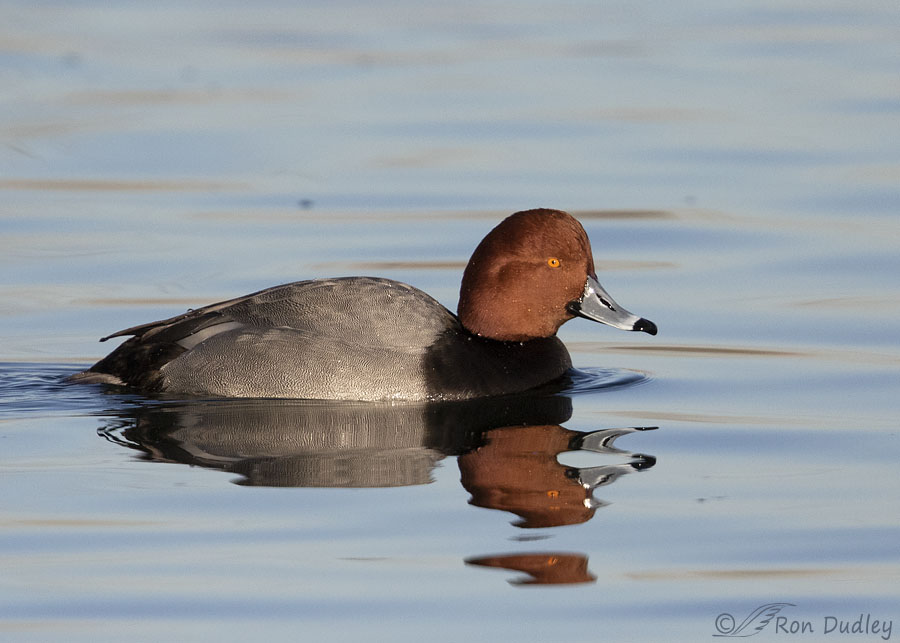
With their gleaming cinnamon head setting off a body marked in black and business gray I think drake Redheads are unusually handsome ducks. This guy was looking particularly dapper in the morning light, despite the cockeyed reflection of his head and bill that seemed to throw some confusion into the mix about what he actually looked like.
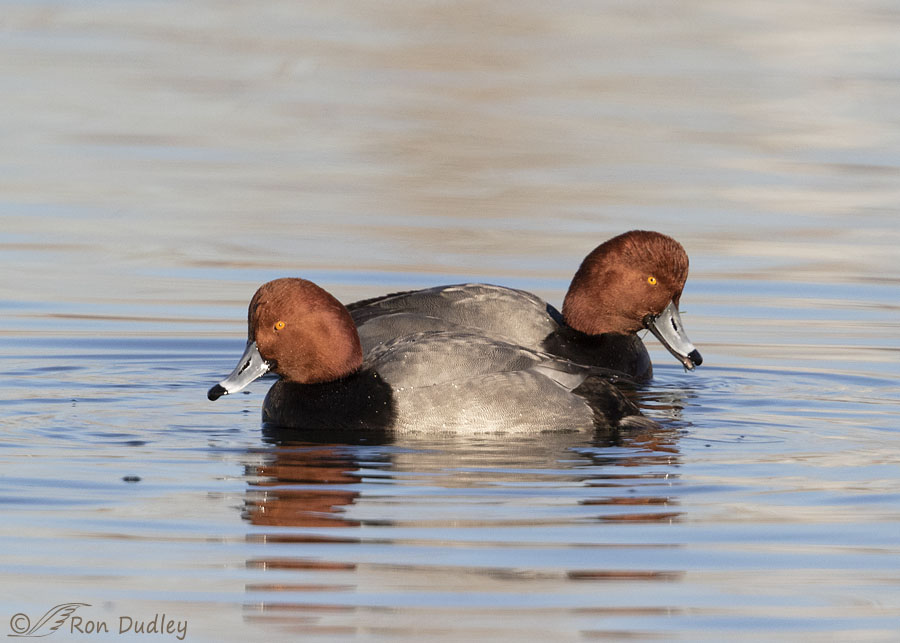
There were three Redheads close to the shore, and to me, and they were feeding on the pondweed in the shallow water. Here the two males were doing their best imitation of Frick and Frack as they stuck close to each other for a few moments in poses that were near mirror images of each other.
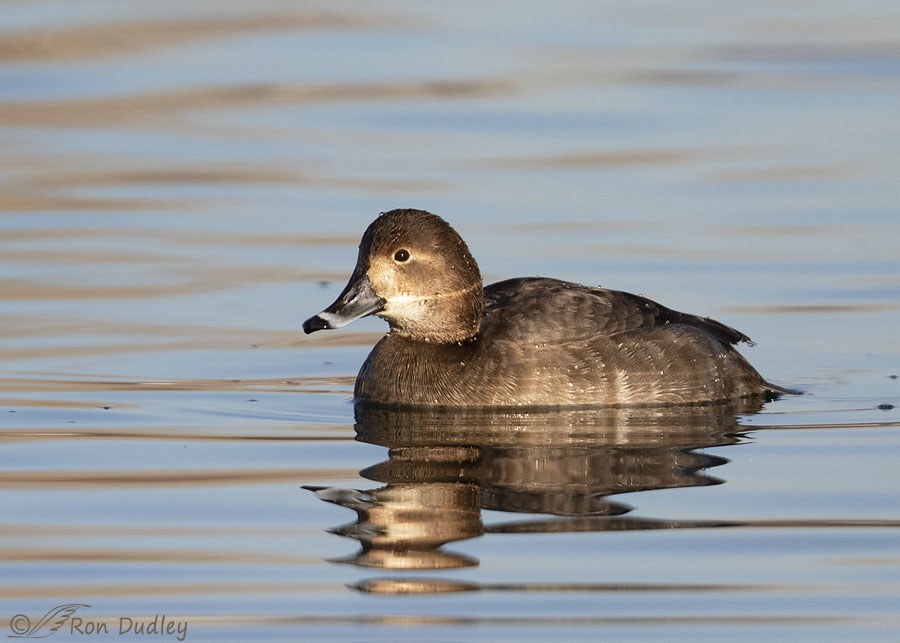
The lone female was a little more standoffish, with the two males and with me, but she was always hanging around nearby.
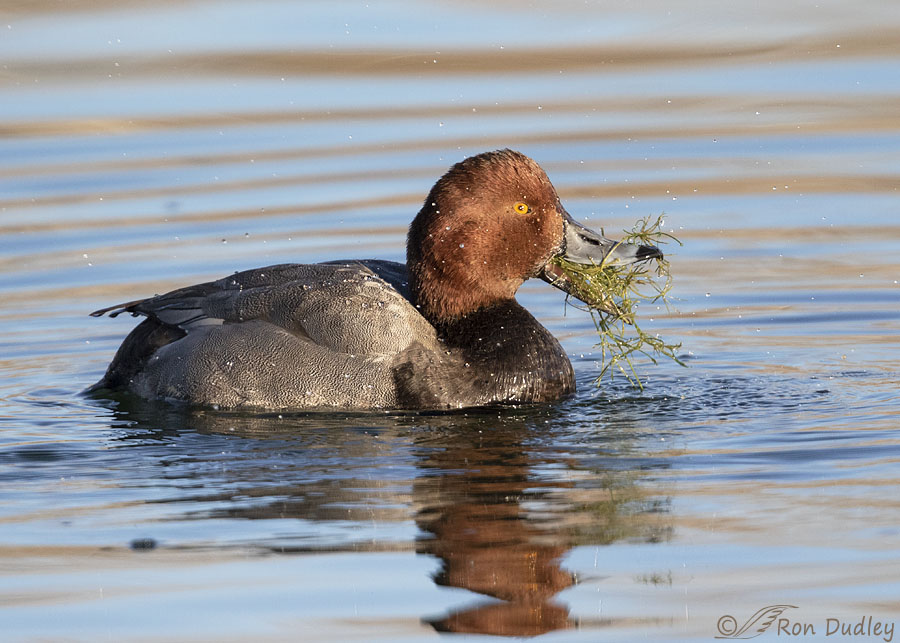
The two males put away an amazing amount of pondweed.
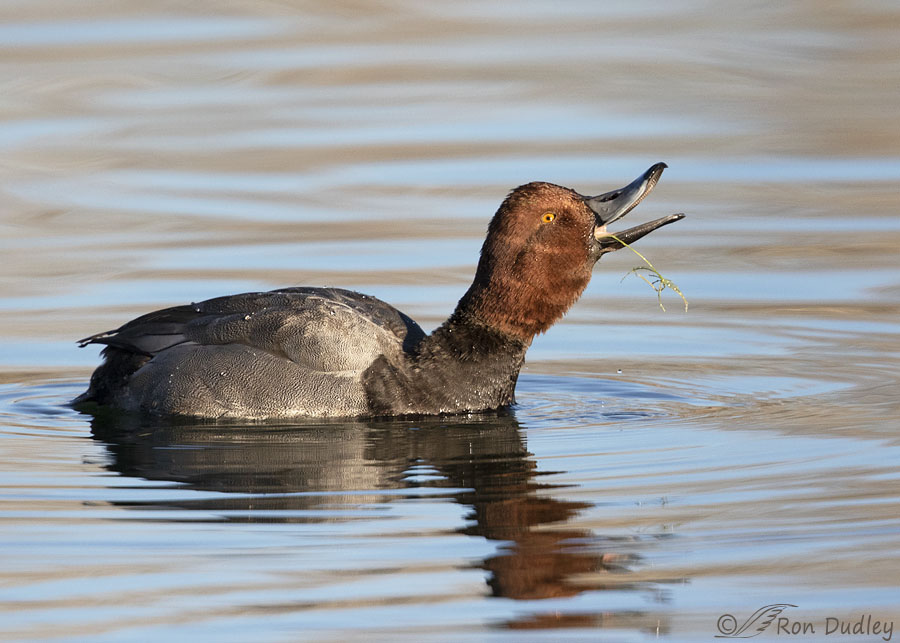
One of the males seemed to have some difficulty swallowing (possibly an incorrect interpretation on my part). Whenever he tried to swallow he would repeatedly point his bill upward and pump his neck up and down before the mouthful disappeared down his throat. I don’t recall this being a typical behavior of the species and the other male didn’t do it so I’m not sure what was really going on.
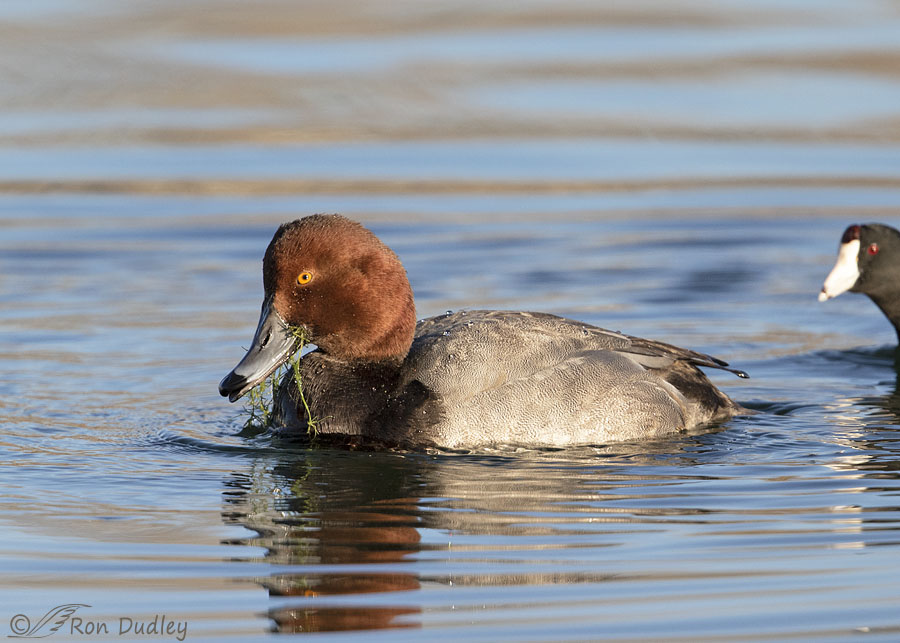
At least one of the ubiquitous coots was usually trailing immediately behind the male Redheads looking for leftovers. I never saw a coot challenge one of the larger ducks for its meal but they weren’t shy about making a nuisance of themselves. The Redheads seemed to take it all in stride.
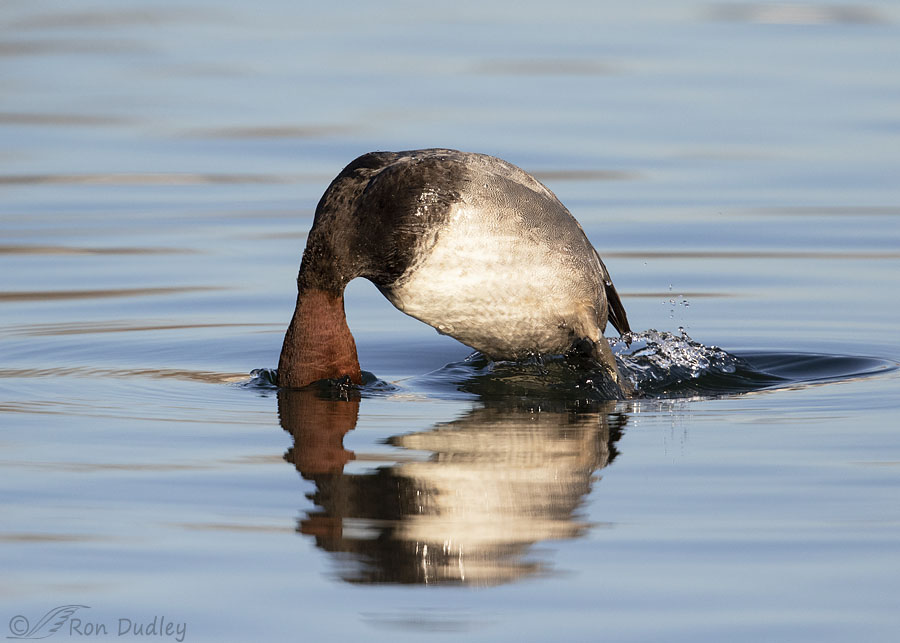
One of my goals that morning was to catch a Redhead in a dive at the exact moment when its eye was just above the water’s surface.
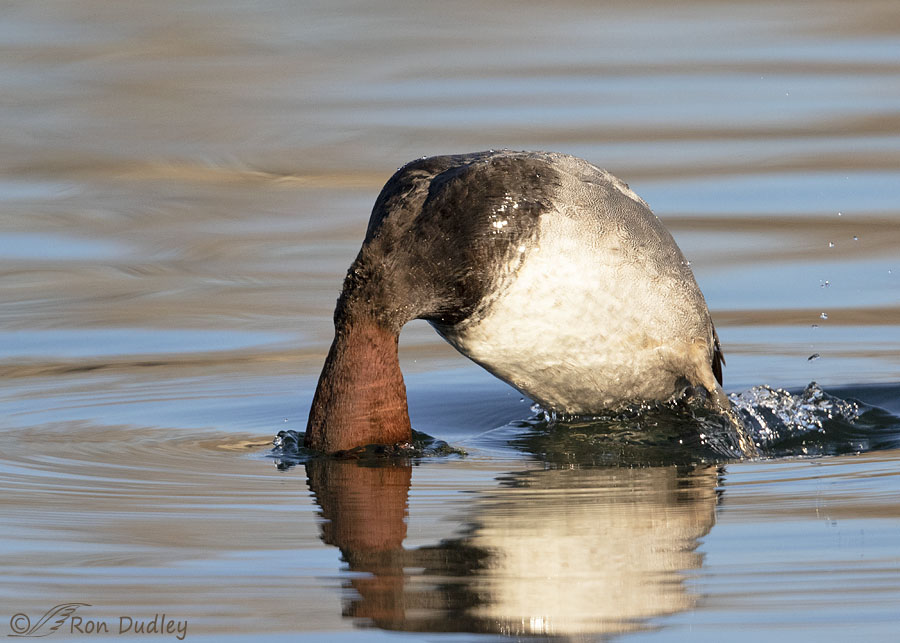
I tried again and again but…
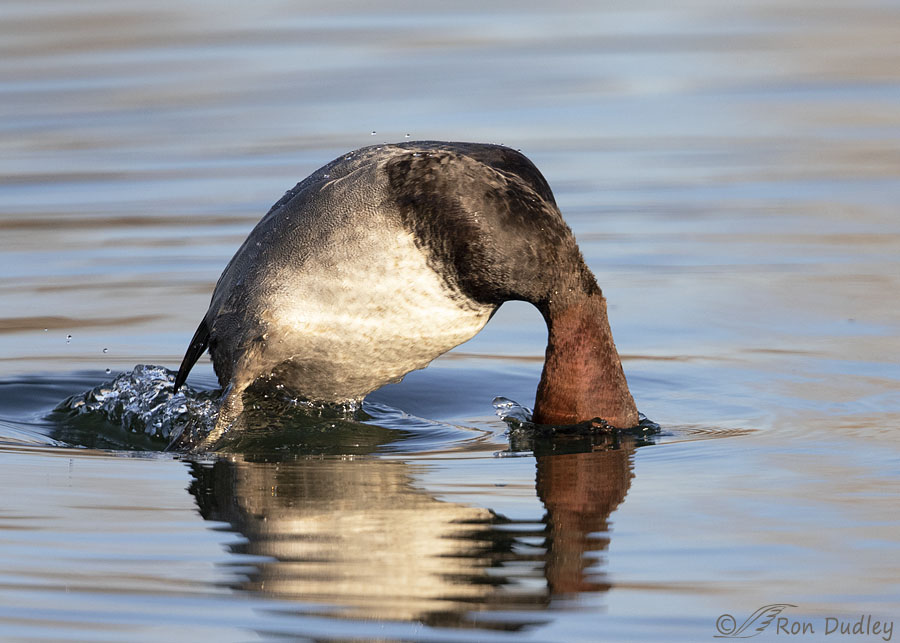
never succeeded with a photo that didn’t have something else wrong with it, such as a poor light angle. I think these three photos are interesting but I’d have preferred to get the eye just above the water.
But the timing of these three photos, and others like them, suggests something to me about the predictability of the speed of my reflexes. Usually when I saw one of the ducks begin to dive the second photo in my burst, which all three of these photos are, caught the duck in almost exactly the same stage of the dive – with the eye just below the water’s surface.
That suggests to me that the speed of the duck’s dive, and the speed of my reflexes, are both very nearly a constant. I guess it doesn’t surprise me but I thought it interesting to have it confirmed.
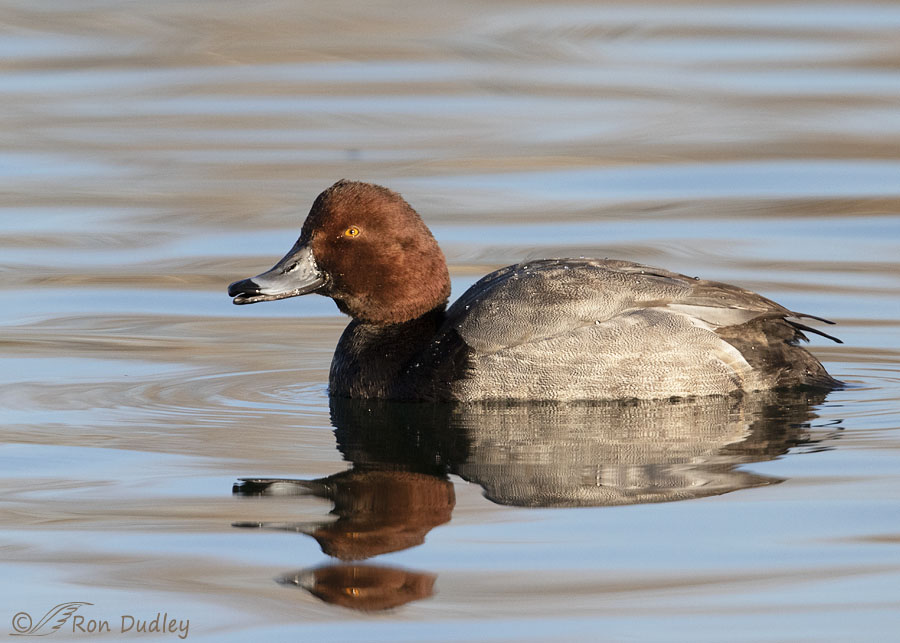
One of the males gave me a brief look at rhynchokinesis, the ability of many birds to flex or bend their upper bill. I had my lens on this guy as I was waiting for him to dive in another of my attempts to catch him with his eye just above the water. His bent bill almost makes it look like he was sneering at me and my feeble attempts.
I wouldn’t be surprised.
Ron
Notes:
- Redheads demonstrate brood parasitism to a greater extent than any other North American duck. As in cowbirds, some folks just can’t forgive them for that. I’m not in that camp.
- Sorry, no image techs today. I ran out of time.


Bendable bill!! That is something I never thought of happening. Thanks so much for continuing to educate. The colors in this pictures are so lovely. As a weaver I am always looking at color combinations and the soft blues with the cinnamon head and greys are fantastic.
There’s just something fascinating about watching ducks dive down, pluck, and gobble down pondweed isn’t there?
It might just be on my end, but unfortunately the photo demonstrating the Redhead’s rhynchokinesis is a broken thumbnail… :/
It’s working on my end, Amy – both on my computer and on my phone.
It’s not showing up on my work computer but I can see it on my home computer. Strange but I’m glad I was able to see the photo. 🙂
Thanks for a new word for my vocabillary, Teech! 🙂 Rhynchokinesis — very interesting. Love the little coot photobomb and the diving ducks. The female is such a subtle beauty.
As far as the last shot goes, I’m thinking Elvis. Thankyou. Thankyouverymuch.
Come to think of it you’re right about Elvis.
I really like the sneer. Very fun series. They were still present when I dropped by a female canvasback for company today. Crappy light today! Next time you are there watch for the rehab canvasback.
You bet I will, April. I hope she sticks around.
The beak flexing is really interesting!
Good.
Too bad the coots can’t take a lesson from their cinnamon-colored brethren, dining so peaceably together! Wonderful photos, I really like the reflection shot in particular, though F&F are quite the pair. And thanks for adding to my vocabulary, although I may never be able to pronounce (or spell) that word without stumbling through it!
Chris, I don’ have any problem pronouncing it. Spelling it correctly is another matter.
Beautiful shots. We have Redheads but in low numbers. It would be nice to see more. As for stealing food, I seldom see coots actually stealing from the larger ducks but they hang around close hoping for a dropped tidbit. But the reverse is common. I often see American Wigeon swimming to coots and stealing any plants hanging from the coot’s bill as it surfaces. They swim to and intently watch the surface of the water where a coot just dove. Sometimes a single coot is attacked by as many as 4 wigeon. But little harm is done and given how much more seriously coots fight with each other, it’s hard to have much sympathy.
Thanks, Dan. It isn’t unusual at all for me to see coots acting very aggressively toward other birds over food or feeding rights. I’ve even seen coots trying to steal fish (of all things) from Pied-billed Grebes. This, from Cornell, pretty much sums up my experience with them
“Ryder (Ryder 1959) listed 11 species of ducks, 16 other species of birds, 2 species of mammals, and 1 each of a fish and reptile as being aggressively threatened and/or pursued by coots in a Utah marsh, with White Pelicans (Pelecanus erythrorhynchus) and Canada Geese (Branta canadensis) being the only species that coots consistently avoided as if through fear.”
Maybe they act more aggressively around here, over food or just because they’re feeling belligerent. I dunno.
You sure nabbed some purty pictures here pardner, even with the fancy word thrown in.
Them fellas are a right handsome bunch, but I’m taken with the lady and that stripe from ‘bout her gape to nape.
👍🤠
Well done, Lyle. Sounds like you might have been handy to have around at the OK Corral.
‘Rhynchokinesis’ and ‘brood parasitism’ – looked up both. Felt like a very bad student because once I read about brood parasitism realized you have described that in at least one previous blog.
Frick & Frack are my fav today!
“I realized you have described that in at least one previous blog.”
Not to worry, Kathleen. Repetition is one of the best ways to learn.
Yet ANOTHER delightful series – and comments.
Thanks to all.
Thanks, EC.
Ron,
I haven’t been out with my camera for a while. I better get out again before certain places close up. Love your pics and comments. “Rhynchokinesis!” REALLY? You probably deserve a PhD in “Birds and stuff!”
I had a similar situation last week with a “rhinovirus!” I kill myself!
Stephen
Stephen, I’ve covered rhynchokinesis a couple of times on my blog in the past. I need to remember that just because I’ve posted stuff like that before doesn’t mean all of my blog followers have seen it. Thanks for the reminder.
Male Redheads ARE beautiful. 🙂 Perhaps the one seeming to have trouble swallowing just had one little piece that wasn’t wanting to go – been there, done that. 😉 Love the dives even if the eye wasn’t showing and the shots certainly are consistent indicating your reflexes – a bit frustrating, I’m sure BUT! Appears their bills to turn up a bit – perhaps that makes it easier to flex it up? Interesting the coot seems to know it’s limits as to what it is going to attack – good news for the Redheads! 😉
“good news for the Redheads!”
And good news for the coots. Redheads appear to be about twice the size of coots so if a greedy coot made a serious attempt it would probably pay the price.
I am not sure of that. Some of our smaller birds punch well above their weight. The corellas for example often chivy the cockatoos off the feeder – despite being probably about half their size.
I guess I’m not sure of it either, EC. But coots are notorious for barging in and stealing food from some other birds. And they never did it with these much larger Redheads. Their motivation for not doing so is the question of course.
Excellent post and another educational one at least for me. Never heard of rhynchokinesis. Very interesting. Outstanding series on the Redheads who are very handsome ducks. After we discussed the ubiquitous Coots yesterday, sure enough you got one. I was taking photos of Buffleheads and others at a riparian pond yesterday morning and there were so many Coots it was driving me crazy trying to get photos without one of them being included.
Ha, like I said yesterday – coots are champion photobombers! Thanks, Everett.
Love the photos! Especially the Fric and Frac shot! Gorgeous birds.
Thank you, Joanne.
Wow, II learned a new word today, even if your persistence did not pay off. Enjoyed the photo of the Push-Me-Pullican. Interestingly, when I studied in Central America I watched a Spanish version of the movie Dr Dolittle. The two-headed llama was called a llamall– the word is visually descriptive of the beast.
Kenneth, sounds like I need to watch Dr. Doolittle. I never have in its entirety. Musicals just aren’t my bag…
I have never seen the movie but did read the books – and thought immediately of Push-Me-Pullme.
Push-me-Pull-you?
WOW– “rhynchokinesis”–that’s a $5.00 word for sure, plus even the concept
of a bendable bill is a news flash to me. “Feathered Photography”
is like a box of chocolates– you never know what you’re gonna get ! That’s
why I look forward to your blog each morning– besides seeing beautiful
critters, I usually learn something new/arcane……..
Kris, given how addicted to chocolate I am I loved your analogy.
Wonderful action shots, and the Frick/Frack shot is gorgeous.
I’m glad you like that shot, Terri. That’s actually the photo I chose, out of the ten of them, as my featured image on Facebook.
Fantastic shots!!!! Love em all!
Better luck next time with a shot of the eye before the ducks head goes under.
Thanks, Dick.